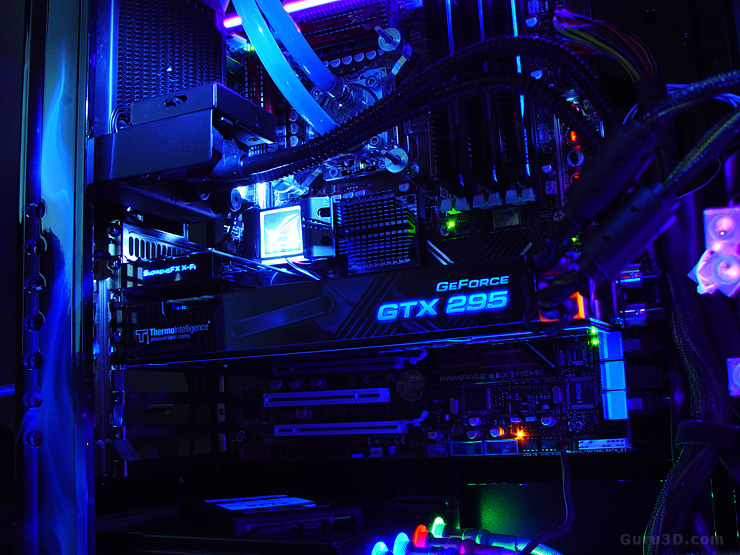A 101 on GTX 295 technology
A 101 on GTX 295 technology
Alright, first let's start off with a crash course on what the GTX 295 actually is. Dual-GPU based graphics cards... the past few years we've seen them a couple of times. The previous one released from team green (NVIDIA) was their GeForce 9800 GX2. By itself a pretty interesting card. Though every now and then also haunted by driver issues. This is the reality of any multi-GPU solution really. Rendering a game with multiple graphics processors is increasingly more difficult opposed to using just one GPU.
And I know I have said this many times already, this is why typically I prefer a single GPU based high-end graphics card over a dual-GPU based solution, that doesn't mean though that things have improved over the years.
The biggest positive for the GTX 295 for example is that it can continue on existing technology; SLI. And it's exactly what is happening inside that GTX 295 graphics card... the two GPUs are bridged and SLI takes place internally, rendering your games based on profiles in the GeForce drivers, like alternate frame rendering etc.
Sure, there are some snags to Multi-GPU based products though. Typically NVIDIA uses two PCBs which adds more overall cost to the design. Secondly, and that goes for any multi-GPU based system, you can double up everything. This means you now have two GPUs that need to get rid of their heat, which requires extra cooling. You'll need more PSU capacity, you'll need good airflow inside that system. So yeah, not only performance doubles up, everything doubles up. And that also goes for the innards of the graphics card just as well.
Now the GTX 295 is a bit of a weird combo. See, it has the memory volume and frequency of two GTX 260 cards yet the raw shader processor horsepower of two GeForce GTX 280 cards. The single card derivative that came from that was the GTX 275, and when you take two GTX 275 cards and set them up in multi-GPU configuration... that really is a GTX 295.
Reference clock frequencies:
- Memory: 1792 MB (896 MB per GPU)
- Shaders processor: 240 per GPU, 480 in total
- Core frequency: 576 MHz (Texture and ROP units)
- Shader processor: 1242 MHz
One thing is a fact though, it's an awful lot of computing power for sure.
Quick note for the true geeks: Each GPU features seven ROP and framebuffer partitions. Each ROP partition contains four ROP units, providing each GPU with 28 ROP units. Each framebuffer partition is connected to 128 MB of memory, totaling 896 MB of video memory for each GPU, thus times two. Total number of Texture Filtering Units: 160 (80x2).
Let's talk about mother nature and your power bill for a second. See, this card has a 289 Watt peak power consumption. That is a lot of power being consumed at game time, which you can frown upon. There are obviously also a couple of very interesting positives.
You are adding a MASSIVE amount of horsepower to your PC. Seriously, it's even a little crazy when you think about it. You have 2x 240 shader processor cores inside one graphics card... that's a rather incredible amount of horsepower. The fun thing with the product now is that with that much power you can also have it handle future PhysX titles really easily without dedicating a GPU to PhysX, yet keep the raw horsepower the card really has. Heck, the more effects a game has, the better.
Some GeForce GTX 295 facts.
- Fabricated on a 55nm production node
- Two GTX 200 GPUs
- Accumulated 480 shader processors
- 2x 896 MB of memory = 1792 MB = 1.8 GB
Some of you might wonder why NVIDIA decided not to use GDDR5 memory on this product, and that is a very valid question. Fact is that the GTX 200 memory controllers simply do not support GDDR5. So expect GDDR5 integration in the next generation GeForce graphics products.
| GeForce 9800 GTX |
GeForce GTX 260 Core 216 |
GeForce GTX 280 |
GeForce GTX 295 | |
| Stream (Shader) Processors | 128 | 216 | 240 | 240x2 |
| Core Clock (MHz) | 675 | 576 | 602 | 576 |
| Shader Clock (MHz) | 1675 | 1242 | 1296 | 1242 |
| Memory Clock (MHz) x2 | 1100 | 999 | 1053 | 999 |
| Memory amount | 512 MB | 896 MB | 1024 MB | 1792 MB |
| Memory Interface | 256-bit | 448-bit | 512-bit | 448-bit x2 |
| HDCP | Yes | Yes | Yes | Yes |
| Two Dual link DVI | Yes | Yes | Yes | Yes |
We can already tell you that we were at the very least impressed by its cooling. Face it, two GPUs generate a lot of heat, especially with a dual PCB design and a 289W TDP. Luckily... we have liquid cooling at hand.
 The BFG GeForce GTX 295 H2OC LE - all chilled down and looking just breezy.
The BFG GeForce GTX 295 H2OC LE - all chilled down and looking just breezy.
